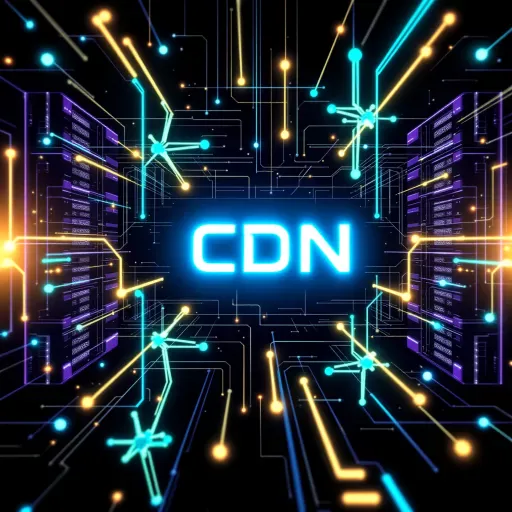Picture this: a potential customer clicks on your website link, excited to learn about your products or services. Three seconds pass. Five seconds. Still loading. Click – they’re gone, probably to your competitor’s site that loads instantly. This scenario plays out millions of times daily across the web, and it’s costing small businesses serious money.

Content Delivery Networks (CDNs) have become the secret weapon that levels the playing field between small businesses and corporate giants. But what exactly is a CDN, and why should your business care? Let’s break it down in plain English.
What Is a Content Delivery Network?
Think of a CDN as a network of digital warehouses strategically placed around the world. Instead of storing physical goods, these warehouses (called edge servers) store copies of your website’s content – images, videos, stylesheets, and other files.
When someone visits your website, the CDN automatically serves content from the warehouse closest to them. If your business is based in Melbourne but a customer in Perth wants to view your site, they’ll receive content from a server in Western Australia rather than waiting for data to travel across the continent.
According to HTTP Archive’s 2024 Web Almanac, a CDN is “a geographically distributed network of servers designed to provide high availability, enhanced performance, and improved security for web content and applications.”
The Speed Revolution: How CDNs Transform Website Performance

Lightning-Fast Load Times
The most obvious benefit of using a CDN is dramatically improved website speed. Research from KVY Technology shows that websites taking longer than three seconds to load can experience over a 50% increase in bounce rate.
Here’s the maths that matters: a one-second delay in page load time can lead to a 7% drop in conversions. For a small business generating $100,000 annually online, that’s potentially $7,000 lost revenue from slow loading times alone.
CDNs tackle this problem through several mechanisms:
- Reduced latency by serving content from geographically closer servers
- Caching mechanisms that store frequently accessed content for instant delivery
- Load balancing that distributes traffic across multiple servers to prevent bottlenecks
Real-World Performance Gains
The numbers speak for themselves. Studies cited by BlazingCDN show that businesses implementing CDNs often see:
- Up to 50% faster load times for end-users
- 20% reduction in page load times (as experienced by Etsy)
- 70% reduction in server load on origin servers
Beyond Speed: The Hidden Benefits of CDNs
Rock-Solid Reliability
Small businesses can’t afford downtime. Every minute your website is offline represents lost customers and revenue. CDNs provide redundancy – if one server fails, traffic automatically routes to the next available server.
This distributed approach means your website stays online even during:
- Server maintenance
- Unexpected traffic spikes
- Regional internet outages
- Cyber attacks
Enhanced Security Protection
CDNs aren’t just about speed; they’re digital bodyguards for your website. According to FireXCore’s 2024 guide, modern CDNs offer:
- DDoS attack protection by distributing malicious traffic across multiple servers
- SSL/TLS encryption for secure data transmission
- Web Application Firewalls (WAFs) that filter out harmful traffic
- Bot protection to distinguish legitimate visitors from malicious automated traffic
Global Reach Without Global Infrastructure
Want to sell to customers in New Zealand, Singapore, or the UK? A CDN gives your small business the global presence of a multinational corporation without the massive infrastructure investment.
Your website will load just as quickly for a customer in Auckland as it does for someone in your local suburb, creating a consistent experience that builds trust and credibility worldwide.
The Mobile Revolution: CDNs and Mobile Performance

With mobile traffic now accounting for over half of all web browsing, mobile optimisation isn’t optional – it’s essential. CDNs excel at mobile content delivery through:
- Adaptive content delivery that adjusts based on device capabilities
- Image compression and optimisation for smaller screens
- Reduced data consumption – crucial for users on limited data plans
Research from CacheFly indicates that CDNs can significantly improve mobile site speed by reducing the physical distance data must travel, which is particularly important for mobile users who may be on slower or less reliable connections.
The Economics: CDN Costs vs. Benefits
Breaking Down the Investment
Many small business owners worry about CDN costs, but the reality is more encouraging than you might expect. According to BlazingCDN’s 2024 cost analysis, CDNs operate on flexible pricing models:
- Pay-as-you-go options that scale with your traffic
- Free tiers for small websites just starting out
- Subscription plans starting from as little as $10-30 per month
Return on Investment
The financial benefits often outweigh the costs within months:
- Reduced server costs by offloading traffic from your origin server
- Lower bandwidth expenses through efficient caching
- Increased conversions from faster load times
- Reduced bounce rates leading to better search engine rankings
Amazon CloudFront users report savings of up to 50% on data transfer costs compared to traditional hosting methods.
Choosing the Right CDN for Your Small Business
Key Factors to Consider
When selecting a CDN provider, focus on these critical elements:
Performance Metrics:
- Network size and global coverage
- Average response times
- Uptime guarantees (look for 99.9% or higher)
Security Features:
- DDoS protection capabilities
- SSL certificate support
- Security monitoring and reporting
Pricing Structure:
- Transparent pricing without hidden fees
- Scalable plans that grow with your business
- Free trial periods to test performance
Support Quality:
- 24/7 customer support
- Technical documentation and resources
- Easy integration with existing systems
Popular CDN Options for Small Businesses
Cloudflare offers an excellent free tier and is known for combining security with performance. Their basic paid plans start around $20 per month and include robust DDoS protection.
Amazon CloudFront integrates seamlessly with other Amazon Web Services and offers pay-as-you-go pricing that’s ideal for businesses with variable traffic.
CacheFly provides flexible pricing with free plans supporting up to 5TB of data, making it perfect for growing small businesses.
Implementation: Getting Started with CDNs

The Setup Process
Implementing a CDN isn’t as technical as it sounds. Most providers offer:
- One-click integration with popular platforms like WordPress, Shopify, and Wix
- Step-by-step setup guides for custom websites
- Migration assistance to help transfer existing content
Measuring Success
Once your CDN is active, monitor these key metrics:
- Page load speed improvements
- Bounce rate reductions
- Conversion rate increases
- Server load decreases
- User engagement metrics
Future-Proofing Your Business
Emerging Technologies
The CDN landscape continues evolving with exciting developments:
- Edge computing bringing processing power closer to users
- AI-powered optimisation for predictive content caching
- 5G integration for ultra-fast mobile experiences
- Enhanced security features to combat evolving cyber threats
According to BlazingCDN’s 2024 trends report, the CDN market is expected to reach USD 36.51 billion by 2028, driven by increasing demand for fast, secure content delivery.
Staying Competitive
Small businesses that embrace CDN technology now position themselves advantageously for the future. As customer expectations for speed and reliability continue rising, having a robust content delivery strategy becomes increasingly crucial for maintaining competitive edge.
Taking Action: Your Next Steps
The evidence is clear: CDNs offer small businesses a powerful tool for improving website performance, enhancing security, and providing better user experiences. The question isn’t whether you should implement a CDN, but rather which solution best fits your specific needs and budget.
Start by evaluating your current website performance using tools like Google PageSpeed Insights or GTmetrix. Identify your pain points – slow loading times, high bounce rates, or frequent downtime. Then research CDN providers that address these specific challenges within your budget.
Remember, in today’s digital marketplace, speed isn’t just a nice-to-have feature – it’s a business necessity. Your customers expect fast, reliable access to your content, and a CDN helps ensure you can deliver on those expectations consistently.
The investment in CDN technology pays dividends through improved user satisfaction, better search engine rankings, increased conversions, and enhanced security. For small businesses looking to compete effectively in the digital space, a CDN isn’t just a technical upgrade – it’s a strategic business decision that can drive growth and success.

